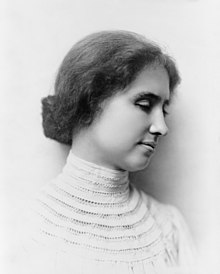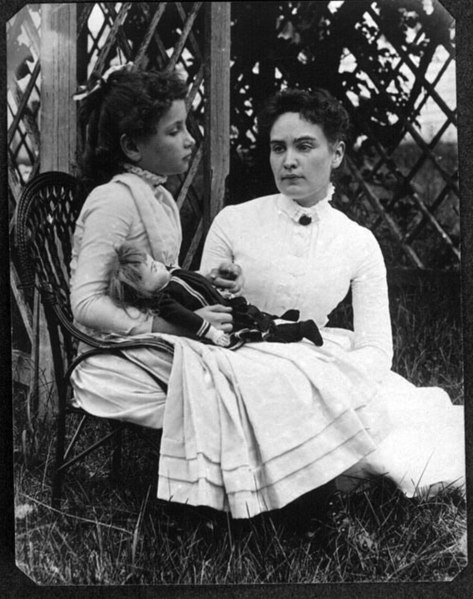Hellen Keller

The story of Helen Keller is a moving and inspiring one. Helen was born in a town in Alabama, in America, in 1880. She was healthy when she was born. But at the age of just nineteen months she lost her sight and hearing because of a high fever. Despite all this, Helen grew up to be an inspiration to many people.
The first seven years of Hellen's life were very difficult. She could not play like an ordinary child because she could not see or hea. Helen was therefore unable to learn how to speak and was uncontrollable as a child. She often became angry but invented many different signs of her own so that she could make herself understood.
Little Helen's life would take a dramatic turn just before her seventh birthday. A woman called Anne Mansfield Sullivan came to live with the Keller family. She would become Helen's teacher.

Miss Sullivan was twenty years old. She had graduated from the Perkins school for the blind. She had lost much of her own sight, but was able to see again after she had had some operation
Helen would always remember the day her teacher came to live with her. She considered it to be "the most important day" in her life.

Miss Sullivan started her first lesson with Helen by giving her a doll and spelling with her fingers the letters D-O-L-L in Helen's hand. Miss Sullivan aimed to teach Helen to connect objects with words by doing this.
At first Helen did not understand that Miss Sullivan was spelling a word. In Helen's world there were no words because she could not hear. One day Miss Sullivan took Helen outside into the garden. The teacher held Helen's hand under the water pump. As cold water poured onto Helen's hand, Miss Sullivan spelled with her fingers the letter W-A-T-E-R in Helen's other hand.
All of a sudden, Helen understood. She realized that what was being done in her palm meant the cool liquid she could feel with her other hand. It was like a miracle. The word "water" was one opf the few words Helen had learned when she was a baby.
Helen was overjoyed to have made the connection between the word and the object. This gave Helen great hope for the future. At last there was not only a way for people to communicate with her, but Helen would now be able to learn how to express her own thoughts and feelings.
From then on, Helen's education quickly progressed. She learned the alphabet and also how to read Braille, which is a system of printing used by blind people.
Then, when Helen was ten years old she told Miss Sullivan that she also wanted to learn how to speak. Helen had learned of a deaf and blind girl in Norway who had learned how to talk. A lady called Miss Sarah Fuller taught Helen how to speak. Helen would gently feel the movement of Miss Fuller's tongue and lips and then copy them.
However, Helen had learned only the basic way to speak from Miss Fuller. So it took a lot of practice, and for a long time people could not understand what Helen was trying to say. Helen was able to read Braille and now she also knew how to speak. Helen went to study for a B.A degree at Radcliffe College. Miss Sullivan sat by Helen all through her classes and homework, spelling the words from books into Helen's hand. Helen graduated cumlaude in 1904.
Helen also enjoyed writing. She wrote many articles for newspapers and magazines. Helen often wrote about blindness, deafness, women's rightsts and other social issues. Her first book, The Story of My Life was published in 1903. It is now available in more than fifty languages.
Helen tried to improve the lives of other people who we're blind or who, like herself, were both deaf and blind. She helped many people around the world by raising money so that deaf and blind people could be educated too. Helen was always eager to show what disabled people could achieve in life.
She was able to communicate with people by gently touching their faces and feeling the movement of their lips. Everyone was impressed by her courage. In 1924 Helen started a fund, which was named after her, to raise money for the blind. The money was used to provide more schools for the blind, as well as books in Braille.
After World War II ended in 1945, Helen met with many was veterans in the United States. Many of men had lost their sight and hearing, or they suffered from other disabilities. Because Helen was also disabled, she could understand their feelings. Helen's visit gave soldiers great courage and hope. She called this period "the crowning experience of my life."
Helen started travelling all over the world. During the eleven years between 1946 and 1957 she visited thirty-five countries. One of her longest trips was taken when she as seventy-five years old. She spent five months visiting various countries in Asia. Wherever she went, Helen gave and received great warmth.
Helen met many world leaders, including US President J.F. Kennedy and India's Prime Minister Jawaharlal Nehru. Through these visits, Helen kept appealing for the need of relief for the disabled,]. She also wanted people to understand that disabled were not special, but like everybody else. In 1964 President Lyndon Johnson presented her with the Presidential Medal of Freedom, the highest award a civilian can receive in the US.
After receiving the oprestigious award, Helen said, "When one door of happiness closes, another opens; but often we look so long at the closed door that we do not see the one which has been open for us," A year after being presented with the medal, Helen was elected to the Women's Hall of Fame at the New York World's Fair.
Helen passed away just before her eighty-eight birthday. Senator Lister Hill of Alabama summed up what people felt about Helen: "She will live on, one of the few, the immortal names not born to die. Her spirit will endure as long as man can read and stories can be told as the woman who showed the world there are no boundaries to courage and faith."
Komentar
Posting Komentar